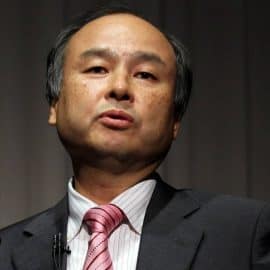


| Personal Brand Presence | 7 / 10 |
| Authoritativeness | 7 / 10 |
| Expertise | 5 / 10 |
| Influence | 5 / 10 |
| Overall Rating | 6 / 10 |
Son, who was born and reared in Japan, finished his education in America and earned an economics degree from the University of California, Berkeley. Son’s financial support of businesses that provide blockchain- or crypto-related services generally takes the shape of many multimillion dollar investments.
The seasoned businessman not only oversees one of Asia’s biggest conglomerate holding businesses, but also serves as a director of Yahoo Japan, which was first established as a joint venture between Yahoo and SoftBank.
Son is in charge of SoftBank, which closely collaborates with top cryptocurrency-focused businesses like exchanges, blockchain platforms, and settlement services.
As part of this endeavor, SoftBank also manages the technology-focused venture capital firm SoftBank Vision Fund, which was established with over $100 billion in funding. SoftBank Vision Fund and SoftBank Vision Fund 2 were established in 2017 and 2019, respectively, and have now invested more than $130 billion in prestigious startups and cryptocurrency businesses.
The finance manager of SoftBank deserves praise for attempting to highlight the advantages. After registering increases for the second consecutive quarter, Yoshimitsu Goto of the Japanese conglomerate declared that the Vision Funds had “hit the bottom.” The company, led by Masayoshi Son, has resumed focusing on new investments, so the improving performance might have given shareholders some relief. However, the stock fell 9%, the most in a year, due to a larger loss of 931 billion yen ($6.2 billion) for the three months ending in September.
Son’s primary priority in 2022 is anticipated to be finding and integrating top-tier cryptocurrency companies to maintain its expanding presence in the industry. The $400 million financing for FTX, which raised the exchange’s valuation to $8 billion, has so far been SoftBank’s most prominent investment. Son also intends to increase the number of roles for analysts, associates, and vice presidents at SoftBank Vision Fund in Japan.
By the end of 2022, SoftBank’s investment in India is projected to increase to up to $10 billion as part of its global growth. The resignation of its chief operational officer earlier this year resulted in a management reorganization at the Japanese fintech behemoth as well. The regional composition of SoftBank’s portfolio as of the end of January was 42% in the Americas, 28% in Europe, and 15% in China.
Solana has demonstrated strong performance, driven by increasing adoption, institutional interest, and key partnerships, while facing potential ...
Know MoreIn April 2025, the crypto space focused on strengthening core infrastructure, with Ethereum preparing for the Pectra ...
Know More